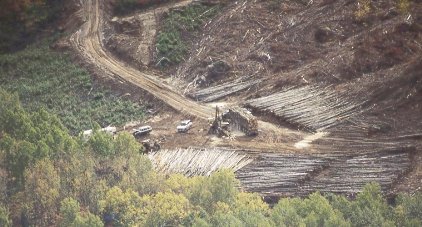
|
Back to Forest Management Applied Burns Fire Rangers Forest Fires Restricted Fire Zones |
 When the pioneers first arrived in the Mississagi River Valley they waged a battle against the magnificent forests that dominated the area. In order to survive, they had to clear enough land to allow them to grow crops for their own sustenance. The lumber industry has become much more closely regulated since the pioneers' first forays into the bush to clear their land. The need to preserve our forests for both their economic and aesthetic value has been recognized. Thus, the Ontario Ministry of Natural Resources devises twenty-year management plans for the province's forests. These plans are divided into five-year segments. The main species present in a stand and the age of the trees is taken into consideration when the plan is made up. Then stands of timber are allocated to logging companies so that each one gets a certain percentage equal to the percentage that it was given in the previous five years. The management plan specifies the cutting method that the loggers will use when harvesting their allocated stand of forest. For instance, when the clear cut method is used, all trees are removed. Another harvesting technique is the selection cut, which leaves trees of a certain size for a later cut. Other cuts which leave trees standing are shelterwood cuts, of which there are several kinds. These are done in order to ensure that animal habitats are not destroyed, or to facilitate reforestation. The shelterwood strip cut is one such method. It is based on a three strip pattern where one strip is cut at a time over a number of years so that the stand is never completely denuded. Reforestation is taken into consideration when the MNR is developing its plans. This is because different species of trees have different requirements for growing. For example, jack pine is not shade tolerant, so they are planted in clear cuts, where there is no shade. Yellow birch is shade intolerant too, but it has an additional requirement. In order to germinate, the seed of the yellow birch must be exposed to mineral soil. Thus, in areas where yellow birch are to be planted the ground must be scarified. This means that a skidder is used to remove debris from the ground. Other species, such as maple, are shade tolerant; they need shade to grow. Thus, maple is not planted. Instead maples reseed themselves in strip cuts. The logging industry has always been important to the Mississagi River Valley. Since the early days the importance of forest management in maintaining this industry has been recognized. Return to Top |
Home | Natural Environment | History | Industry | Personalities/Stories | Credits/Team